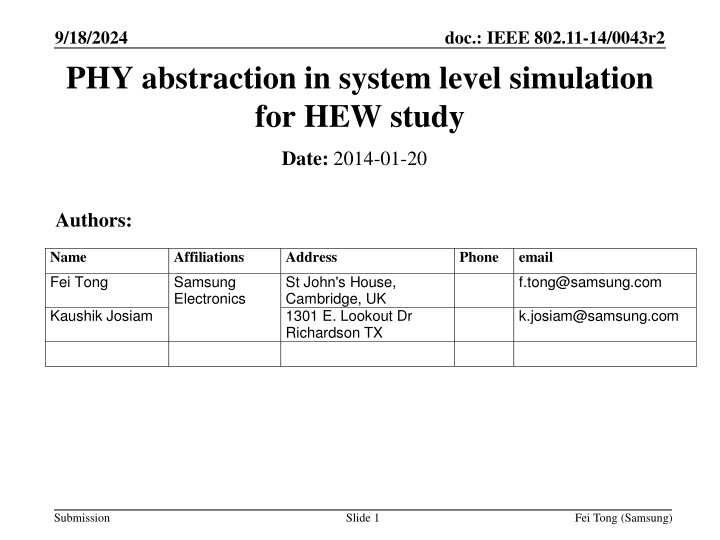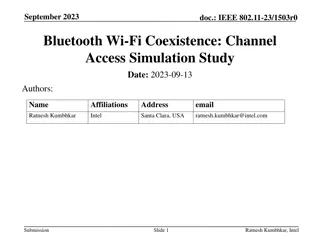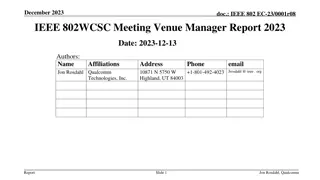System-Level Simulation for HEW Study in IEEE 802.11-14/0043r2
This document discusses abstraction in system-level simulation for High-Efficiency Wireless (HEW) study, focusing on effective Signal-to-Noise Ratio (SNR) mapping, parameter fitting, selection of mapping functions, and simulation conditions/assumptions for IEEE 802.11. The study explores various methods for mapping SNR to bit rate equivalence, incorporating different MCS, FEC types, and fading channel scenarios to calibrate parameters accurately.
Download Presentation

Please find below an Image/Link to download the presentation.
The content on the website is provided AS IS for your information and personal use only. It may not be sold, licensed, or shared on other websites without obtaining consent from the author.If you encounter any issues during the download, it is possible that the publisher has removed the file from their server.
You are allowed to download the files provided on this website for personal or commercial use, subject to the condition that they are used lawfully. All files are the property of their respective owners.
The content on the website is provided AS IS for your information and personal use only. It may not be sold, licensed, or shared on other websites without obtaining consent from the author.
E N D
Presentation Transcript
9/18/2024 PHY abstraction in system level simulation for HEW study doc.: IEEE 802.11-14/0043r2 Date: 2014-01-20 Authors: Name Affiliations Address Phone email Fei Tong Samsung Electronics St John's House, Cambridge, UK 1301 E. Lookout Dr Richardson TX f.tong@samsung.com Kaushik Josiam k.josiam@samsung.com Submission Slide 1 Fei Tong (Samsung)
9/18/2024 doc.: IEEE 802.11-14/0043r2 Outline Effective SNR Mapping and parameter fitting results Fitting result sensitivity to bandwidth Parameterise PER over PDU length Frequency-domain modelling of interference Temporal-domain modelling of interference Submission Slide 2 Fei Tong (Samsung)
9/18/2024 doc.: IEEE 802.11-14/0043r2 Effective SNR Mapping Mapping a vector (SNR) to a scalar; four candidate methods EESM RBIR RBIR-BICM MMIB Share a similar processing flow The function is in the form: Map per sub-carrier SNR to a bit rate equivalence Take average over the per-subcarrier bit rate equivalence Map the averaged bit rate equivalence back to an effective SNR All methods need fitting for and For different MCS, FEC type and fading channel scenario Parameters need to be calibrated by fitting the simulated PER curves : C 1 1 1 N = k = k eff N 0 Submission Fei Tong (Samsung) Slide 3
9/18/2024 doc.: IEEE 802.11-14/0043r2 Selection of Mapping function EESM RBIR/RBIR- BICM MMIB Function for Closed-form Tabulated Closed-form; but not available for 256QAM Tabulated; but not available for 256QAM Limited search range for ( , ) Extra curve fitting for function Function for -1 Closed-form Tabulated Curve fitting Large search range for ( , ) Limited search range for ( , ) For the complexity issue, MMIB will not be evaluated in this presentation Submission Slide 4 Fei Tong (Samsung)
9/18/2024 doc.: IEEE 802.11-14/0043r2 Function (normalised by bit per symbol) Submission Slide 5 Fei Tong (Samsung)
9/18/2024 doc.: IEEE 802.11-14/0043r2 Simulation conditions/assumptions PPDU configuration VHT 40 MHz frame BCC FEC with single spatial stream MCS 0-9 PDU length 1K bytes Channel condition Static frequency-selective channel type (B and D) Receiver assumption Ideal channel estimation Single tap equalisation Floating point Viterbi decoder Submission Slide 6 Fei Tong (Samsung)
9/18/2024 doc.: IEEE 802.11-14/0043r2 BCC fitting results (Chan D) Submission Slide 7 Fei Tong (Samsung)
9/18/2024 doc.: IEEE 802.11-14/0043r2 LDPC fitting results (Chan D) Submission Slide 8 Fei Tong (Samsung)
9/18/2024 doc.: IEEE 802.11-14/0043r2 BCC fitting results (Chan B) Submission Slide 9 Fei Tong (Samsung)
9/18/2024 doc.: IEEE 802.11-14/0043r2 LDPC fitting results (Chan B) Submission Slide 10 Fei Tong (Samsung)
9/18/2024 doc.: IEEE 802.11-14/0043r2 Sensitivity to bandwidth Fitting results obtained on 40 MHz are tested on 20 and 80 MHz cases For 80 MHz, BCC has small but noticeable mismatch; LDPC has no significant mismatch For 20 MHz, BCC has noticeable mismatch; LDPC has small mismatch for some MCSs Submission Slide 11 Fei Tong (Samsung)
9/18/2024 doc.: IEEE 802.11-14/0043r2 80 MHz Bandwidth (BCC Chan D) Submission Slide 12 Fei Tong (Samsung)
9/18/2024 doc.: IEEE 802.11-14/0043r2 80 MHz Bandwidth (LDPC Chan D) Submission Slide 13 Fei Tong (Samsung)
9/18/2024 doc.: IEEE 802.11-14/0043r2 20 MHz Bandwidth (BCC Chan D) Submission Slide 14 Fei Tong (Samsung)
9/18/2024 doc.: IEEE 802.11-14/0043r2 20 MHz Bandwidth (LDPC Chan D) Submission Slide 15 Fei Tong (Samsung)
9/18/2024 doc.: IEEE 802.11-14/0043r2 Impact of PDU length For the same MCS, FER varies depending on PDU length; but BER does not Submission Slide 16 Fei Tong (Samsung)
9/18/2024 doc.: IEEE 802.11-14/0043r2 Parameterize FER on PDU length (1) Alt. 1. Tabulate PER on MCS, PDU length Need to store a set of curves and interpolate for other length Submission Slide 17 Fei Tong (Samsung)
9/18/2024 doc.: IEEE 802.11-14/0043r2 Parameterize FER on PDU length (2) Alt. 2. Map BER to FER using a model function Map SNR to BER(Pe) based on 1000B PDU FER ~ 1-(1- Pe)L/D, fitting D per MCS Submission Slide 18 Fei Tong (Samsung)
9/18/2024 doc.: IEEE 802.11-14/0043r2 Interference modelling frequency selectivity In general, the interference is frequency selective; However, modelling frequency selectivity interference in system level simulator is expensive Frequency selectivity modelling involves CIR generation and FFT processing; There may exist multiple interferers For lower power interference, may not be significantly different from a white-noise interference modelling With respect to average power, the null subcarrier is deeper than the peak subcarrier in the interference spectrum With same power, instant white-noise has greater dynamic range than interference signal Submission Slide 19 Fei Tong (Samsung)
9/18/2024 doc.: IEEE 802.11-14/0043r2 Instant interference power density The interference power density peak matters more than the null Submission Slide 20 Fei Tong (Samsung)
9/18/2024 doc.: IEEE 802.11-14/0043r2 Compare interference models Interference power is defined w.r.t. to noise power Submission Slide 21 Fei Tong (Samsung)
9/18/2024 doc.: IEEE 802.11-14/0043r2 Interference modelling temporal dynamics In OBSS, the interfering signal may not be aligned with intended signal in time; interfering signal may appear at any time with respect to the intended signal Assessing the packet reception once either at the preamble and the end of the frame is pessimistic Due to aggregation, some MPDUs may be correctly received Accurately modelling the temporal dynamic interference is costly A good balance is to assess the reception for each MPDU duration in an A-MPDU Submission Slide 22 Fei Tong (Samsung)
9/18/2024 doc.: IEEE 802.11-14/0043r2 Summary Effective SNR Mapping All methods discussed give similar accuracy, RBIR/RBIR-BICM have advantage of small search space Parameters in the mapping function are not sensitive for 40 and 80 MHz bandwidths but for 20 MHz bandwidth Parameterise PER over PDU length Fitted BER vs. FER mapping function can avoid storing too many FER tables Frequency-domain modelling of interference For lower power interference, white-noise model is sufficient Temporal-domain modelling of interference Multiple check point in a frame Time resolution up to MPDU duration Submission Slide 23 Fei Tong (Samsung)
9/18/2024 doc.: IEEE 802.11-14/0043r2 Reference [1] PHY Abstraction for System Simulation , IEEE 802.11-04/0174 [2] PHY Abstraction for HEW Evaluation Methodology , IEEE 802.11- 13/1059r0 [3] PHY Abstraction for HEW System Level Simulation , IEEE 802.11- 13/1131r0 [4] PHY Abstraction for HEW System Level Simulation , IEEE 802.11- 13/1390r0 Submission Slide 24 Fei Tong (Samsung)
9/18/2024 doc.: IEEE 802.11-14/0043r2 Thank you! Submission Slide 25 Fei Tong (Samsung)























